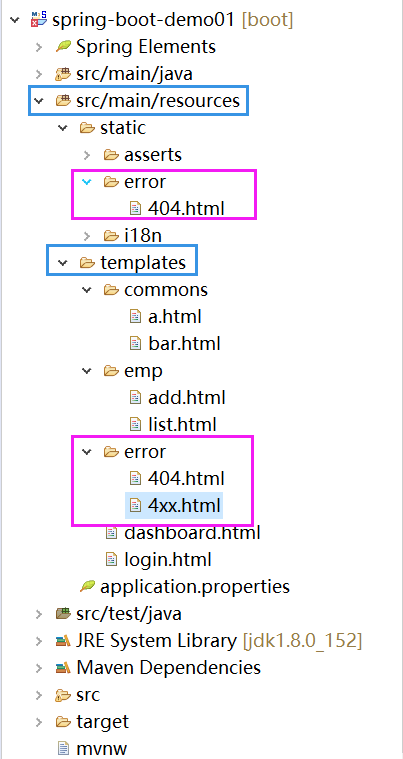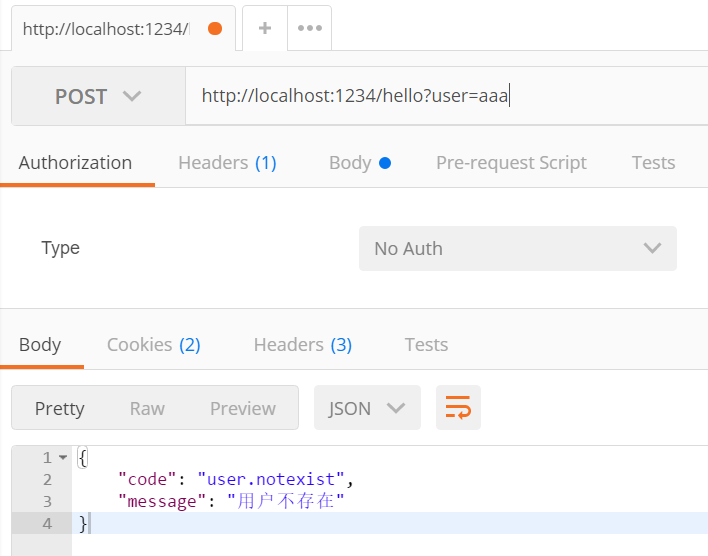默认效果:
1)、浏览器,返回一个默认的错误页面
1.1 请求头

1.2返回结果

2)、如果是其他客户端,默认响应一个json数据
2.1请求头

2.2返回结果
{ "timestamp": "2018-11-25T08:22:36.343+0000", "status": 404, "error": "Not Found", "message": "No message available", "path": "/golden" }
步骤:
1)系统出现4xx或者5xx之类的错误;ErrorPageCustomizer就会生效(定制错误的响应规则);
2) 根据相应规则来到/error请求;被BasicErrorController处理;
3)响应页面;被Controller处理后去哪个页面是由DefaultErrorViewResolver解析得到的;
源码解析
public class ErrorMvcAutoConfiguration {
// 系统出现错误以后来到error请求进行处理;(相当于web.xml注册错误页面规则) @Bean public ErrorPageCustomizer errorPageCustomizer() { return new ErrorPageCustomizer(this.serverProperties, this.dispatcherServletPath); } /** * {@link WebServerFactoryCustomizer} that configures the server's error pages. */ private static class ErrorPageCustomizer implements ErrorPageRegistrar, Ordered { private final ServerProperties properties; private final DispatcherServletPath dispatcherServletPath; protected ErrorPageCustomizer(ServerProperties properties, DispatcherServletPath dispatcherServletPath) { this.properties = properties; this.dispatcherServletPath = dispatcherServletPath; } @Override public void registerErrorPages(ErrorPageRegistry errorPageRegistry) { ErrorPage errorPage = new ErrorPage(this.dispatcherServletPath .getRelativePath(this.properties.getError().getPath())); errorPageRegistry.addErrorPages(errorPage); } @Override public int getOrder() { return 0; } } } public class ErrorProperties { /** * Path of the error controller. */ @Value("${error.path:/error}") private String path = "/error"; }
public class ErrorMvcAutoConfiguration { // 系统出现错误以后来到error请求进行处理;(相当于web.xml注册错误页面规则) @Bean public ErrorPageCustomizer errorPageCustomizer() { return new ErrorPageCustomizer(this.serverProperties, this.dispatcherServletPath); } /** * {@link WebServerFactoryCustomizer} that configures the server's error pages. */ private static class ErrorPageCustomizer implements ErrorPageRegistrar, Ordered { private final ServerProperties properties; private final DispatcherServletPath dispatcherServletPath; protected ErrorPageCustomizer(ServerProperties properties, DispatcherServletPath dispatcherServletPath) { this.properties = properties; this.dispatcherServletPath = dispatcherServletPath; } @Override public void registerErrorPages(ErrorPageRegistry errorPageRegistry) { ErrorPage errorPage = new ErrorPage(this.dispatcherServletPath .getRelativePath(this.properties.getError().getPath())); errorPageRegistry.addErrorPages(errorPage); } @Override public int getOrder() { return 0; } } @Configuration @ConditionalOnProperty(prefix = "server.error.whitelabel", name = "enabled", matchIfMissing = true) @Conditional(ErrorTemplateMissingCondition.class) protected static class WhitelabelErrorViewConfiguration { //默认的SpringBoot错误页面 private final SpelView defaultErrorView = new SpelView( "<html><body><h1>Whitelabel Error Page</h1>" + "<p>This application has no explicit mapping for /error, so you are seeing this as a fallback.</p>" + "<div id='created'>${timestamp}</div>" + "<div>There was an unexpected error (type=${error}, status=${status}).</div>" + "<div>${message}</div></body></html>"); @Bean(name = "error") @ConditionalOnMissingBean(name = "error") public View defaultErrorView() { return this.defaultErrorView; } // If the user adds @EnableWebMvc then the bean name view resolver from // WebMvcAutoConfiguration disappears, so add it back in to avoid disappointment. @Bean @ConditionalOnMissingBean public BeanNameViewResolver beanNameViewResolver() { BeanNameViewResolver resolver = new BeanNameViewResolver(); resolver.setOrder(Ordered.LOWEST_PRECEDENCE - 10); return resolver; } } } public class ErrorProperties { /** * Path of the error controller. */ @Value("${error.path:/error}") private String path = "/error"; }
public class ErrorMvcAutoConfiguration { @Bean @ConditionalOnMissingBean(value = ErrorController.class, search = SearchStrategy.CURRENT) public BasicErrorController basicErrorController(ErrorAttributes errorAttributes) { return new BasicErrorController(errorAttributes, this.serverProperties.getError(), this.errorViewResolvers); } } public abstract class AbstractErrorController implements ErrorController { private final ErrorAttributes errorAttributes; private final List<ErrorViewResolver> errorViewResolvers; public AbstractErrorController(ErrorAttributes errorAttributes) { this(errorAttributes, null); } //解析错误页面 protected ModelAndView resolveErrorView(HttpServletRequest request, HttpServletResponse response, HttpStatus status, Map<String, Object> model) { for (ErrorViewResolver resolver : this.errorViewResolvers) { ModelAndView modelAndView = resolver.resolveErrorView(request, status, model); if (modelAndView != null) { return modelAndView; } } return null; } } /**取出配置項:server.error.path中的值。如果沒有,則取error.path的值,如果還沒有,則默認為/error路徑*/ @Controller @RequestMapping("${server.error.path:${error.path:/error}}") public class BasicErrorController extends AbstractErrorController { @RequestMapping(produces = "text/html")//产生html类型的数据;浏览器发送的请求来到这个方法处理 public ModelAndView errorHtml(HttpServletRequest request, HttpServletResponse response) { HttpStatus status = getStatus(request); Map<String, Object> model = Collections.unmodifiableMap(getErrorAttributes( request, isIncludeStackTrace(request, MediaType.TEXT_HTML))); response.setStatus(status.value()); //去哪个页面作为错误页面;包含页面地址和页面内容 ModelAndView modelAndView = resolveErrorView(request, response, status, model);
//如果为空,返回error视图(在ErrorMvcConfiguration中配置的@Bean) return (modelAndView != null) ? modelAndView : new ModelAndView("error", model); } //产生json数据,其他客户端来到这个方法处理; @RequestMapping @ResponseBody public ResponseEntity<Map<String, Object>> error(HttpServletRequest request) { Map<String, Object> body = getErrorAttributes(request, isIncludeStackTrace(request, MediaType.ALL)); HttpStatus status = getStatus(request); return new ResponseEntity<>(body, status); } } public class DefaultErrorViewResolver implements ErrorViewResolver, Ordered { private static final Map<Series, String> SERIES_VIEWS;
private final ResourceProperties resourceProperties; static { Map<Series, String> views = new EnumMap<>(Series.class); views.put(Series.CLIENT_ERROR, "4xx"); views.put(Series.SERVER_ERROR, "5xx"); SERIES_VIEWS = Collections.unmodifiableMap(views); } @Override public ModelAndView resolveErrorView(HttpServletRequest request, HttpStatus status, Map<String, Object> model) { ModelAndView modelAndView = resolve(String.valueOf(status), model); if (modelAndView == null && SERIES_VIEWS.containsKey(status.series())) { modelAndView = resolve(SERIES_VIEWS.get(status.series()), model); } return modelAndView; } private ModelAndView resolve(String viewName, Map<String, Object> model) {
//默认SpringBoot可以去找到一个页面? error/404 String errorViewName = "error/" + viewName;
//模板引擎可以解析这个页面地址就用模板引擎解析 TemplateAvailabilityProvider provider = this.templateAvailabilityProviders .getProvider(errorViewName, this.applicationContext); if (provider != null) {
//模板引擎可用的情况下返回到errorViewName指定的视图地址 return new ModelAndView(errorViewName, model); }
//模板引擎不可用 return resolveResource(errorViewName, model); } // private ModelAndView resolveResource(String viewName, Map<String, Object> model) {
//从静态资源文件夹下解析对应的页面 error/404.html for (String location : this.resourceProperties.getStaticLocations()) { try { Resource resource = this.applicationContext.getResource(location); resource = resource.createRelative(viewName + ".html"); if (resource.exists()) { return new ModelAndView(new HtmlResourceView(resource), model); } } catch (Exception ex) { } } return null; } }
静态资源文件夹路径
@ConfigurationProperties(prefix = "spring.resources", ignoreUnknownFields = false) public class ResourceProperties { private static final String[] CLASSPATH_RESOURCE_LOCATIONS = { "classpath:/META-INF/resources/", "classpath:/resources/", "classpath:/static/", "classpath:/public/" }; /** * Locations of static resources. Defaults to classpath:[/META-INF/resources/, * /resources/, /static/, /public/]. */ private String[] staticLocations = CLASSPATH_RESOURCE_LOCATIONS; }
2)、如果定制错误响应
1、如何定制错误的页面
1)、有模板引擎的情况下;error/状态码; 【将错误页面命名为 错误状态码.html 放在模板引擎文件夹里面的error文件夹下】,发生此状态码的错误就会来到 对应的页面;
我们可以使用4xx和5xx作为错误页面的文件名来匹配这种类型的所有错误,精确优先(优先寻找精确的状态码.html);
页面能获取的信息:
timestamp:时间戳
status:状态码
error:错误提示
exception:异常对象
message:异常消息
errors:JSR303数据校验的错误都在这里
2)、没有模板引擎(模板引擎找不到这个错误页面),静态资源文件夹下找
3)、以上都没有错误页面,就是默认来到SpringBoot默认的错误提示页面
2、如何定制错误的json数据;
1)、自定义异常处理&返回定制json数据;

一、页面请求出错
1. 自定义异常:
public class UserNotExistException extends RuntimeException { private static final long serialVersionUID = -7200824453209817228L; public UserNotExistException() { super("用户不存在"); } }
2. Controller调用
@Controller public class HelloController { @RequestMapping("/hello") @ResponseBody public String createInvoice(@RequestParam("user") String user) { if(user.equals("aaa")) { throw new UserNotExistException(); } return "hello world"; } }
3. 5xx.html
<!DOCTYPE html> <html xmlns:th="http://www.thymeleaf.org"> <head> <meta charset="UTF-8"> <title>5xx.html</title> </head> <body> timestamp:[[${timestamp}]] <br> status:[[${status}]] <br> error:[[${error}]] <br> exception:[[${exception}]] <br> errors:[[${errors}]] <br> message:[[${message}]] <br> </body> </html>
4. 正确结果

5. 错误结果

二、json错误定制
1.编写异常处理器
@ControllerAdvice public class MyExceptionHandler { //1、浏览器客户端返回的都是json @ResponseBody @ExceptionHandler(UserNotExistException.class) public Map<String,Object> handleException(Exception e){ Map<String,Object> map = new HashMap<>(); map.put("code","user.notexist"); map.put("message",e.getMessage()); return map; } }
请求:

页面也显示json数据

但若想让浏览器返回错误页面,客户端返回json数据,且是自适应的,怎么办呢?
源码解析
@Controller @RequestMapping("${server.error.path:${error.path:/error}}") public class BasicErrorController extends AbstractErrorController { @RequestMapping(produces = MediaType.TEXT_HTML_VALUE) public ModelAndView errorHtml(HttpServletRequest request, HttpServletResponse response) { HttpStatus status = getStatus(request); //status就是端口号 Map<String, Object> model = Collections.unmodifiableMap(getErrorAttributes( request, isIncludeStackTrace(request, MediaType.TEXT_HTML))); response.setStatus(status.value()); ModelAndView modelAndView = resolveErrorView(request, response, status, model); return (modelAndView != null) ? modelAndView : new ModelAndView("error", model); } } public abstract class AbstractErrorController implements ErrorController {
protected HttpStatus getStatus(HttpServletRequest request) { Integer statusCode = (Integer) request .getAttribute("javax.servlet.error.status_code"); if (statusCode == null) { return HttpStatus.INTERNAL_SERVER_ERROR; } try { return HttpStatus.valueOf(statusCode); } catch (Exception ex) { return HttpStatus.INTERNAL_SERVER_ERROR; } } }
@ControllerAdvice public class MyExceptionHandler { @ExceptionHandler(UserNotExistException.class) public String handleException(Exception e, HttpServletRequest request){ Map<String,Object> map = new HashMap<>(); //传入我们自己的错误状态码 4xx 5xx /** * Integer statusCode = (Integer) request .getAttribute("javax.servlet.error.status_code"); */ request.setAttribute("javax.servlet.error.status_code",500); map.put("code","user.notexist"); map.put("message","用户出错啦"); request.setAttribute("ext",map); //下面自定义异常返回结果时,将获取到此request作用域中的数据 //转发到/error return "forward:/error"; } }
但是这种方式无法返回map对象里自定义的数据到页面
Spring Boot 默认的实现原理如下:
public class BasicErrorController extends AbstractErrorController {
//SpringBoot 默认的返回错误html页面代码 @RequestMapping(produces = MediaType.TEXT_HTML_VALUE) public ModelAndView errorHtml(HttpServletRequest request, HttpServletResponse response) { HttpStatus status = getStatus(request); Map<String, Object> model = Collections.unmodifiableMap(getErrorAttributes( request, isIncludeStackTrace(request, MediaType.TEXT_HTML))); response.setStatus(status.value()); ModelAndView modelAndView = resolveErrorView(request, response, status, model); return (modelAndView != null) ? modelAndView : new ModelAndView("error", model); }
//Spring Boot 默认的返回json数据请求 @RequestMapping public ResponseEntity<Map<String, Object>> error(HttpServletRequest request) { Map<String, Object> body = getErrorAttributes(request, isIncludeStackTrace(request, MediaType.ALL)); HttpStatus status = getStatus(request); return new ResponseEntity<>(body, status); } }
public abstract class AbstractErrorController implements ErrorController { private final ErrorAttributes errorAttributes; protected Map<String, Object> getErrorAttributes(HttpServletRequest request, boolean includeStackTrace) { WebRequest webRequest = new ServletWebRequest(request); return this.errorAttributes.getErrorAttributes(webRequest, includeStackTrace); } } @Order(Ordered.HIGHEST_PRECEDENCE) public class DefaultErrorAttributes implements ErrorAttributes, HandlerExceptionResolver, Ordered { @Override public Map<String, Object> getErrorAttributes(WebRequest webRequest, boolean includeStackTrace) { Map<String, Object> errorAttributes = new LinkedHashMap<>(); errorAttributes.put("timestamp", new Date()); addStatus(errorAttributes, webRequest); addErrorDetails(errorAttributes, webRequest, includeStackTrace); addPath(errorAttributes, webRequest); return errorAttributes; } }
3)、将我们的定制数据携带出去
出现错误以后,会来到/error请求,会被BasicErrorController处理,响应出去可以获取的数据是由
getErrorAttributes得到的(是AbstractErrorController(ErrorController)规定的方法);
1、完全来编写一个ErrorController的实现类【或者是编写AbstractErrorController的子类】,放在容器中;
2、页面上能用的数据,或者是json返回能用的数据都是通过errorAttributes.getErrorAttributes得到;
容器中DefaultErrorAttributes.getErrorAttributes();默认进行数据处理的;
@AutoConfigureBefore(WebMvcAutoConfiguration.class) @EnableConfigurationProperties({ ServerProperties.class, ResourceProperties.class,WebMvcProperties.class }) public class ErrorMvcAutoConfiguration { private final ServerProperties serverProperties; //当容器中没有ErrorAttributes类型的bean时,才走默认的,所以我们自定义ErrorAttributes的实现类就可以实现定制化 @Bean @ConditionalOnMissingBean(value = ErrorAttributes.class, search = SearchStrategy.CURRENT) public DefaultErrorAttributes errorAttributes() { return new DefaultErrorAttributes( this.serverProperties.getError().isIncludeException()); } }
Spring Boot1.5.10版本
//给容器中加入我们自己定义的ErrorAttributes,用其实现类,避免重写多个无需改造的方法 @Component public class MyErrorAttributes extends DefaultErrorAttributes { @Override public Map<String, Object> getErrorAttributes(RequestAttributes requestAttributes,boolean includeStackTrace) { Map<String, Object> map = super.getErrorAttributes(requestAttributes,includeStackTrace); map.put("company","everjiankang"); //自定义属性
map.put("name","超轶绝尘"); return map; } }
Spring Boot 2.0 版本
import java.util.Map;
// import org.springframework.boot.web.servlet.error.DefaultErrorAttributes; servlet的可以成功执行 //import org.springframework.boot.web.reactive.error.DefaultErrorAttributes; reactive 也有这个类,但是执行不了 import org.springframework.stereotype.Component; import org.springframework.web.context.request.WebRequest; @Component public class MyErrorAttributes extends DefaultErrorAttributes{ @Override public Map<String, Object> getErrorAttributes(WebRequest webRequest, boolean includeStackTrace) {
//获取到上文中异常处理类中设置到request作用域中的“ext”属性 requeste.setAtrribute("exgt",map);
Map<String,Object> extMap = (Map<String, Object) webRequest.getAttribute("ext", RequestAttributes.SCOPE_REQUEST);
Map<String,Object> map = super.getErrorAttributes(webRequest, includeStackTrace); map.put("name", "xiaochao");
map.put("ext", extMap); //将异常处理类中的自定义信息返回给页面
return map; } }
public interface WebRequest extends RequestAttributes {
}
public interface RequestAttributes {
int SCOPE_REQUEST = 0;
int SCOPE_SESSION = 1;
}
Spring Webflux 版本,执行未成功
在Spring boot 2.1.0版本中,第一个参数变成了org.springframework.web.reactive.function.server.ServerRequest类型,需要引入jar包
但是此段代码不能适用。如何自定义详情查看Spring Boot官方文档
Spring 5 之 Spring Webflux 开发 Reactive 应用
<!-- 此依赖 会依赖于Netty --> <dependency> <groupId>org.springframework.boot</groupId> <artifactId>spring-boot-starter-webflux</artifactId> <!--【改】增加“flux”四个字符--> </dependency>
//import org.springframework.boot.web.reactive.error.DefaultErrorAttributes; reactive 也有这个类,但是执行不了